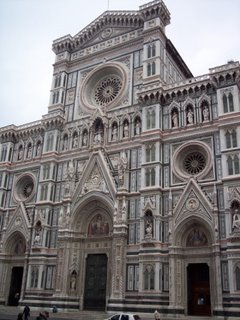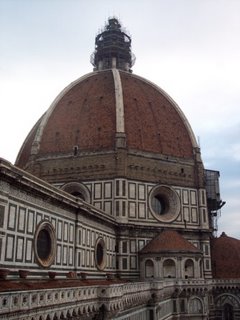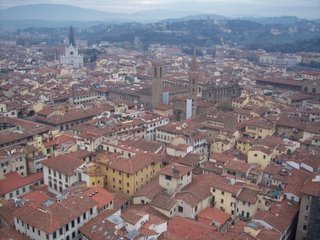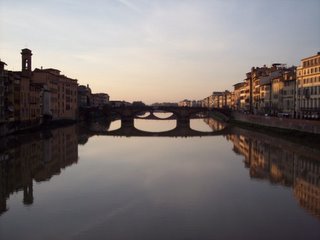
And then another day another beautiful Italian city!
A few images of the magnificent Firenze - the second one from the Campanile (Bell Tower) of the Duomo (first pics) - 414 steps up.... arrrggghhhh keep thinking stair master!
The Basilica di Santa Maria del Fiore is the cathedral church, or Duomo, of the Catholic Archdiocese of Florence, noted for its distinctive dome. Its name (which translates as "Saint Mary of the Flower") refers to the lily, symbol of Florence. The cathedral complex includes the church proper, the baptistery and the campanile (bell tower).
The walls are covered in alternate vertical and horizontal bands with marble from Carrara (white), Prato (green), Siena (red), Lavenza and a few other places. These marble bands had to repeat the decorations of the Baptistery and Giotto's belltower. There are two lateral doors and six lateral windows, notable for their delicate tracery and ornaments. Only the four windows, closest to the transept, admit light; The other two are merely ornamental. The clerestory windows are round, a common feature in Italian Gothic. The floor of the church was laid in marble in the 16th century.During its long history, this cathedral has been the seat of the Council of Florence (1439) and witnessed the murder of Giuliano de' Medici on 26 April 1478 (with Lorenzo the Magnifico barely escaping death).
The duomo originally had a wooden dome, built by Arnolfo di Cambio. In 1418 a competition was held to design a new dome (or cupola) for the cathedral. The two competitors were Lorenzo Ghiberti (famous for his work on the "Gates of Paradise" doors at the Baptistery) and Filippo Brunelleschi. Brunelleschi constructed a wooden model with the help of Donatello and Nanni di Banco. Brunelleschi won by a nose. Ghiberti, appointed coadjutator, mocked these plans and called them unfeasable. Brunelleschi then pretended a sickness and gave the project to Ghiberti. But Ghiberti soon had to recognize that the whole project was beyond him. In 1423 Brunelleschi was back in charge and took over sole responsibility.
The distinctive octagonal design of the dome, resting on a drum and not on the roof itself, allowed for the entire dome to be built without the need for scaffolding. Work had started on the dome in 1420 and was completed in 1436; the cathedral was consecrated by Pope Eugenius IV on 1436-03-25 (the first day of the year, according to the Florentine calendar). It was the first 'octagonal' dome in history (The Roman Pantheon, a circular dome, was built in 118-128 C.E. without support structures) to be built without a wooden supporting frame, and was the largest dome built at the time (it is still the largest masonry dome in the world).




This was taken from the top of the Campanile. A Campanile is a free standing bell tower, and this one, designed and partially built by Giotto, is almost 85m high.
Of course Firenze is home to probably the most famous sculpture in the world, Michaelangelo's David. This statue is said to be a masterpiece of Renaissance sculpture and one of Michelangelo's two greatest works of sculpture, along with the Pietà. It is carved from a single piece of flawed marble, and is 434cm tall. David portrays the Biblical David at the moment that he decides to engage Goliath. This 5.17 m marble statue was commissioned as a symbol of the Florentine Republic.
Michelangelo's David is based on the artistic discipline of disegno, which is built on knowledge of the male human form. Under this discipline, sculpture is considered to be the finest form of art because it mimics divine creation. Because Michelangelo adhered to the concepts of disegno, he worked under the premise that the image of David was already in the block of stone he was working on — in much the same way as the human soul is thought to be found within the physical body. It is also an example of the contrapposto style of posing the human figure.
The proportions are not quite true to the human form; the head and upper body are somewhat larger than the proportions of the lower body. While some have suggested that this is of the mannerist style, the most commonly accepted explanation is that the statue was originally intended to be placed on a church façade or high pedestal, and that the proportions would appear correct when the statue was viewed from some distance below.
There is controversy, however, over the statue's supposed Biblical reference, since the statue portrays an uncircumcised male, whereas the historical King David was undoubtedly circumcised. Because of this fact, some art historians believe that "David" was actually the name of the model who posed for the statue, rather than King David himself, and that Michelangelo claimed the Biblical reference to make it acceptable to the Christian world. Again, this theory is merely speculation.
It has also been theorized that this was a conscientious decision, a consequence of Michelangelo's endeavor to emulate the ancient Greek aesthetic ideals, which regarded the circumcised penis as mutilated and inferior.
The statue was originally placed in the Piazza della Signoria, just in front of the Palazzo della Signoria. To protect it from damage, in 1873 it was moved to the Accademia Gallery. This is a photo of the copy - you are not allowed to photograph the original in the Galleria dell'Accademia. Finally, sunset over the Arno, taken from the Ponte Vecchio, which is Europe's largest segmented arch bridge and has many shops built into it.
Finally, sunset over the Arno, taken from the Ponte Vecchio, which is Europe's largest segmented arch bridge and has many shops built into it.It is said that the economic concept of bankruptcy originated here: when a merchant could not pay his debts, the table on which he sold his wares (the "banco") was physically broken ("rotto") by soldiers, and this practice was called "bancorotto" (broken table; possibly it can come from "banca rotta" which means "broken bank"). Not having a table anymore, the merchant was not able to sell anything.
No comments:
Post a Comment